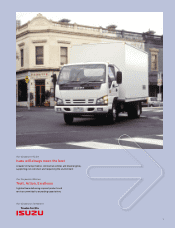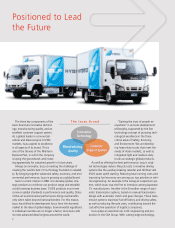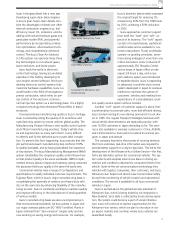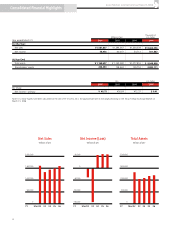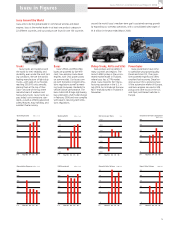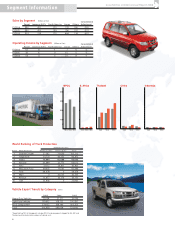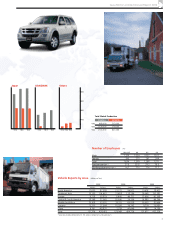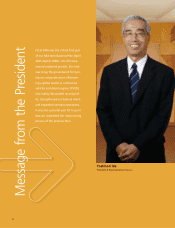Isuzu 2006 Annual Report Download - page 13
Download and view the complete annual report
Please find page 13 of the 2006 Isuzu annual report below. You can navigate through the pages in the report by either clicking on the pages listed below, or by using the keyword search tool below to find specific information within the annual report.
11
Isuzu Motors Limited Annual Report 2006
Q1: How will you deal with the projected
decline in domestic truck demand?
A1: We are trying to minimize the impact of declining domes-
tic truck demand by increasing market share as well as expanding
fringe profits of domestic sales. We are aiming for sales share of
30% in medium-duty and heavy-duty trucks and 40% in light-du-
ty trucks in or before the fiscal year ended March 2008. Currently
we are making progress ahead of plan, with sales share of 28.8%
and 39.7%, respectively. Meanwhile we are also working on im-
proving the earnings capability of sales companies, concentrating
on increasing profits from ancillary businesses such as service and
parts, used vehicles, and insurance, and reducing or restructur-
ing borrowings to develop a management structure that is able to
make a profit even when there is a significant decline in new vehi-
cle demand. We are developing a new life-cycle business model for
domestic operations so that we can offer customers a more com-
prehensive, value-added service.
Q2: Isuzu’s new Mid-term Business Plan is
focusing on expanding and strengthening
overseas operations. What progress have you
made so far and what is your outlook for the
rest of the plan period?
A2: Overseas sales accounted for 57% and domestic sales 43%
of the total in the fiscal year ended March 2006. Although the in-
crease in the overseas sales ratio is modest, the overseas operat-
ing profit ratio improved dramatically from approximately 30%
(domestic 70%) to 60% (domestic 40%) in the fiscal year ended
March 2006. We sustained top market share in commercial ve-
hicles for the 23rd consecutive year in Thailand and 17 years in
Australia, and recorded earnings growth in many other regions
outside Japan. It is also worth mentioning that all unprofitable
businesses returned to the black, especially the North American
SUV business. Moving forward, we expect the growth of our over-
seas business to compensate easily for the decline in domestic
earnings.
We have continued to strengthen our overseas sales struc-
ture, establishing sales companies in Spain, Benelux, and Malaysia
in the fiscal year ended March 2005, and establishing a sales
company in Mexico and making our Australian sales company a
wholly owned subsidiary in the following fiscal year. We recently
established a joint venture with a local company to begin selling
trucks and buses in a big way in the Ukraine. We plan to continue
expanding our sales capability in other regions moving forward,
thereby steadily increasing sales volume and increasing our already
large overseas weighting.
Q3: Isuzu is planning a full model change of
its light-duty and medium-duty trucks that
are positioned as global products. What are
the main features and competitive advantage
of these products?
A3: Their main features are substantial cost savings made pos-
sible by the use of component modules, and improved profit mar-
gins resulting from synergy effects of global standard design. In
comparison with competing products, our global products offer
newly designed vehicles with cutting-edge environmental perfor-
mance, low fuel consumption, and superior safety features at a fair
price due to steeply reduced costs.
We have full confidence in our new, strategic global product
range of light-duty and medium-duty trucks. They are developed
to world standards, incorporating the See technology to maximize
our competitive advantage, yet satisfying the common transporta-
tion requirement around the world.
We can achieve significant cost savings through integration
and module sharing between our medium-duty truck business,
with annual sales volume of approximately 40,000 units, and our
light-duty truck business whose annual sales volume is approxi-
mately 200,000 units.
We used to develop domestic products with top-of-the-
range specifications, then simplified these specifications for over-
seas markets, but made no headway in cost reduction and had to
sacrifice profit to remain competitive with other manufacturers.
This is the first time that we have developed overseas standard
specifications, with the concept of domestic specifications incor-
porating luxury add-ons. This approach makes substantial cost
savings possible.
Q4: In what ways do you think that Isuzu’s
balance sheet needs improvement?
A4: We finally managed to clear our “negative legacy” of ex-
traordinary losses associated with restructuring in the fiscal year
ended March 2006. This is a milestone for Isuzu, marking the
completion of the corporate restructuring process. With a healthy
management structure, we are now poised to begin expand-
ing our business in earnest. From this fiscal year, we intend to in-
vest aggressively to enable sustained growth and increase topline
earnings.
Looking at the balance sheet as a financial base for such in-
vestment, with a capital ratio of only 20.9% Isuzu’s equity capital
is still fragile, and interest-bearing debt remains high. Thus our pri-
mary goal is to lower the debt-equity ratio—which improved from
2.5 at the end of March 2005 to 1.4 at the end of March 2006—
to 1.0 or less by the end of March 2008.


